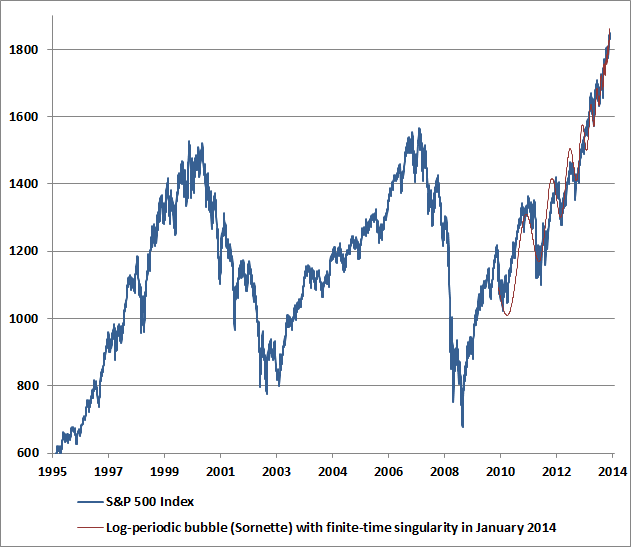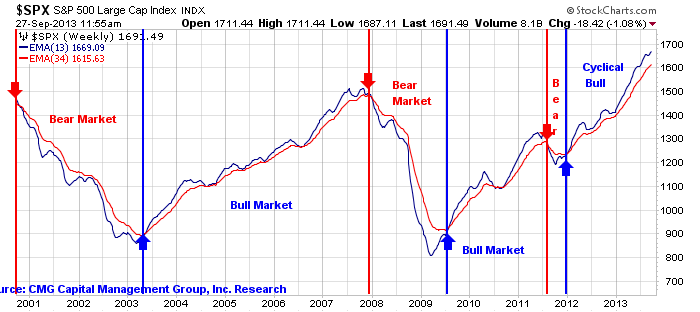Hedging Exposure to an Overvalued Market (Part 1)
Post on: 24 Июнь, 2015 No Comment

What should you do if you are sitting on top of attractive gains on your S&P 500 investment, and you now think the market is overvalued?
On the one hand, there is an argument for not doing anything at all, beyond rebalancing your portfolio to ensure that its weights are in line with your target asset allocation. The logic behind this point of view is a body of research that says market timing is a very difficult strategy to successfully employ on a consistent basis. Arguments based on this logic usually show how being out of the market for just a few key months during a five year period can substantially reduce a portfolio’s rate of return. As far as they go, arguments of this type are correct — the evidence suggests that over time, it is difficult to consistently earn returns above an index by timing a market.
However, arguments of this type should not be taken to imply that one can never successfully time a market. It is certainly possible that from time to time relative valuations (e.g. of bonds versus equities) will get so glaringly out of line that it makes sense to temporarily move beyond your target portfolio weights for each asset class. If you believe that this is the case today in the United States, then your next question is what can I do about it?
In the March and April Index Newsletters we will discuss four different ideas for action you could take.
The first option is to simply sell your S&P 500 index, and reinvest the proceeds in a bond market index fund. If you believe that a sharp drop in equity values would be accompanied by an equally sharp fall in interest rates (caused, perhaps, by the Federal Reserve pumping up the money supply after a crash to avoid a sharp downturn in the economy), then you would want to invest in a fund that tracked the return on long term bonds (e.g. the Vanguard Long Term Bond Index Fund). Such a fund would realize the biggest gain in value as rates fell. If you were unsure about the future course of interest rates, you might instead choose to invest in either a total bond market fund (e.g. the Vanguard Total Bond Market Index Fund) or an intermediate term fund (e.g. the Vanguard Intermediate Term Bond Index Fund).
There are two major considerations with respect to this option. The first is taxes. If your S&P investment is held in a tax-exempt (retirement) account, there is no tax impact. However, if it is held in a taxable account, and you have built up substantial gains, the tax impact could be substantial. The second consideration is missing out on future gains in the S&P if you are wrong about the future direction of the market. If you switch to bonds, there is no way to capture them.
The second option is to purchase a put option on the S&P 500 Index. This puts a floor under the value of your investment in the S&P 500 while still giving you the chance to capture any further upside moves in the equity market. One of the best ways to implement this option is via the purchase of SPX LEAPS (Long-term Equity AnticiPation Securities), which are long dated options on the S&P 500. SPX Index LEAPS are equal to 1/10 the value of the S&P 500. For example, a LEAP with a strike price of 150 is equal to an S&P index value of 1500. To make matters a bit confusing, the multiplier used to calculate the pricing of Index LEAPS is $100. The best way to work through this is via an example.
Assume the S&P 500 index is currently at 1500, and your investment in an S&P 500 index fund is currently worth $100,000. Assume you want to protect yourself against any loss below an S&P 500 index value of 1300. To do this, you need to purchase 8 LEAP index put contracts [$100,000/(130 x $100)]. Each of these LEAP contracts expires in December, 2002, and has a quoted price of 9 3/8, which translates into $937.50 per contract (9 3/8 x $100). The all-in cost to hedge your $100,000 portfolio against drops in the S&P 500 index between now and December, 2002 is therefore $7,500 (8 x $937.50). In other words, you have paid an amount equal to 7.5% of your investment to purchase more than two and a half years of insurance on your equity investment.

What happens if the value of the S&P 500 has fallen to 1000 by December, 2001? The value of your equity investment has fallen by one third, to $66,667. However, this loss has been partially offset by a $30,000 increase in the value of your S&P LEAP puts [(1300-1000) x $100). After taking the cost of the put into account, your net loss is only $10,833 (-$33,333 + $30,000 — $7,500). On the other hand, if the S&P 500 appreciates to 1800, the investor realizes the full upside, and is able to take a capital loss on the premium paid for the LEAPS.
Why don’t more people take advantage of the opportunity to insure their portfolio by buying equity index puts? First, as you can see, the calculations can be a bit daunting. Second, many people may resist signing the additional forms that brokerages require before they allow you to trade options in your account. Third, LEAPS require an additional cash outlay, which some people may not be able to afford. Finally, if the LEAPS are held in a taxable account, they can be a bit complicated. Under Section 1256 of the Internal Revenue Code, they must be marked to market at the end of each year. Practically, this is the same thing as selling them at their fair market value at the end of each year and then instantly repurchasing them at the same price. Any resulting annual capital gain or loss on the LEAPS is automatically treated as 60 percent long term and 40 percent short term.
In the April Index Newsletter we will discuss two other ideas for hedging your exposure in an overvalued market.














